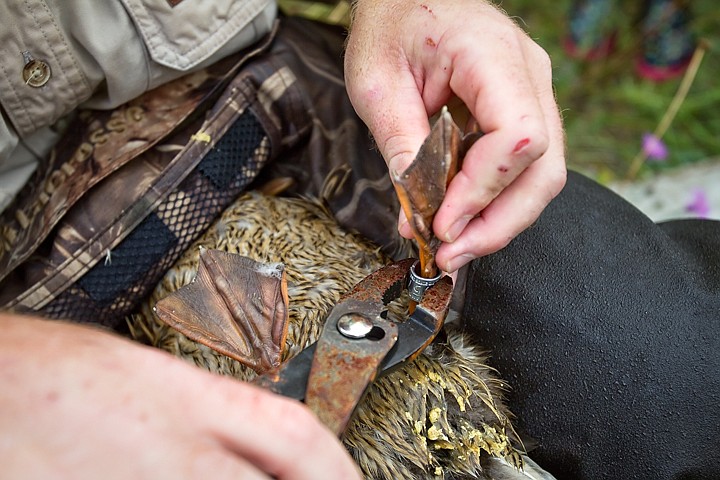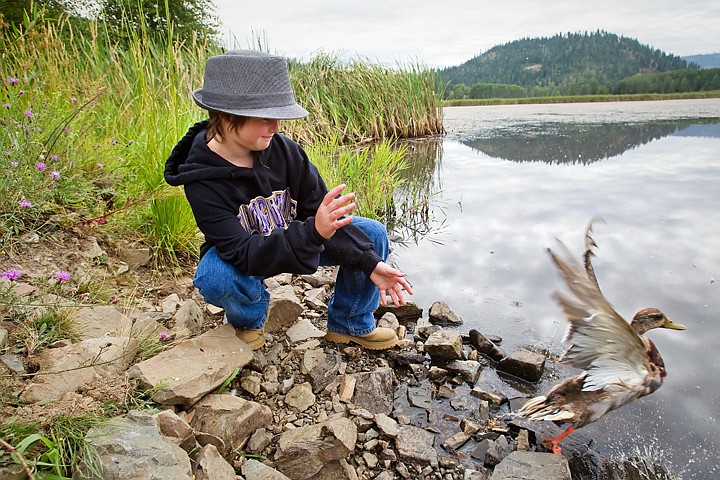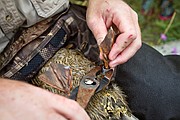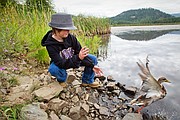'Jewel on a bird'
BILL BULEY | Hagadone News Network | UPDATED 15 years, 4 months AGO
Bill Buley covers the city of Coeur d'Alene for the Coeur d’Alene Press. He has worked here since January 2020, after spending seven years on Kauai as editor-in-chief of The Garden Island newspaper. He enjoys running. | August 12, 2010 9:00 PM
CATALDO - "Who wants to release this one?"
Ten tiny hands belonging to the students from Canyon Elementary Science Magnet School shot up in the air.
Idaho Fish and Game wildlife technician Aaron McKarley nodded at 10-year-old Marie Ferguson, who cautiously took a few steps toward him.
"You ready? Hold his wings. You've got to hold snug, but not too tight," McKarley said as he gently handed the mallard duck to the girl.
Marie walked a few feet to the edge of the Whiteman Lumber pond on the Mission Flats, crouched low and held the duck to the ground.
She let go.
It shot off, quacking and splashing across the murky water as a few cheers went up from the small crowd of about 10 kids and 10 adults gathered on a cool, cloudy Tuesday morning.
The young girl said she liked the feel of the soft, cold feathers in her fingers.
"It's actually kind of funny because they're trying to fly and swim at the same time," she said. "They have pretty strong feet, too."
Attached near those duck feet zooming off toward North Idaho's landscape, the Cataldo Mission peeking out in the distance, was a small, ultra-light aluminum band. McKarley said the bands are a research tool that will help in tracking information about the duck, from migration routes, population changes, nesting, how long they live and behaviors.
Each of the 25 or so birds released Tuesday had its own band number that's recorded in an international database.
"This bird's number is 1146-22534," McKarley said.
"He's shaking," another student said.
"Yeah, he's scared," McKarley answered.
He tries to reduce that fear by slipping the bib of his hip waders over the duck's head, which he said calms them.
"The main thing is, you want to limit the amount of stress and get them banded and out of here. What we're doing here is the most stress, next to duck hunting I guess," he said.
One by one, after McKarley deftly handled pliers to attach a band to each duck's leg, the waterfowl flew or fluttered way.
Students took to their task with energy on this summer morning.
Marie Ferguson said "it was great to be out here."
"I think he has a really cool job," she said.
Why banding
The annual waterfowl banding project has been going on for years, McKarley said. The trap in the slough is open weekdays only for about a month through August, and is checked each day.
The 10-by-10 wire pen funnels from a wide opening into a narrow slot that allows the ducks through, but they can't generally find their way back out.
This year, as many as 75 ducks - mostly mallards and a few wood ducks - have been trapped in one day. They'll wait peacefully until McKarley arrives, dons his camouflage hip waders, ventures into the two-foot-deep water and slowly picks them up, then slips them into canvas bags.
On Tuesday, many splashed and quacked mightily to escape their captor. Some of those caught were released because they were already banded. A wet but patient McKarley never wavered in this task that will see him band and release about 300 ducks this year.
"Now that I've had my morning shower, let's start banding," he said.
While he sat and explained how to determine a duck's age or sex, the job got a little messy.
"It's pooping," a student shouted with dismay.
"Yeah, they're good at that," McKarley said.
Band on
McKarley attaches the band to the leg of each duck within a few minutes, faster when he's working alone rather than explaining the process to students. It must be tight enough to stay on, but loose enough so as not to bother the duck. He adjusts each band so it can't slip over the duck's foot and is hardly noticeable.
"We want this to be as little problem as possible for these birds," he said.
The ducks can carry the bands for years and thousands of miles. They can migrate to Southern California or Florida still wearing the band, which is designed to stay with them for the rest of their life.
By studying the migration routes of the waterfowl, McKarley said they determined four waterfowl flyways in North America - Pacific, which includes Idaho, Central, Mississippi and Atlantic.
"It's for us to better understand what the birds are doing," he said. "We have birds that are banded way up in northern Alaska and ended up in Texas."
The annual winter migration of the ducks, "is kind of like humans moving away from here to some other part of the country."
Some return to the places they were born. Others hook up with different flocks.
Not all ducks take flight come the cold months of November, December, January and February.
"We also have birds that don't even fly. They stay here all winter long," he said. "As long as there's a food source, they stay as long as they can handle the cold."
But most head south.
"Like a lot of people, they want to find warmer weather," McKarley said.
The band numbers are recorded when the ducks are trapped again, or when hunters kill them.
The idea of hunters shooting the birds bothered some students.
"What happens if someone shoots the ducks?" asked 10-year-old Joey Gibbs.
"That's what we're relying on," McKarley said. "We're relying on hunters or people like myself who trap the birds, but more than likely it's going to be hunters who will harvest the bird," he said.
Each band has an 800 number for people to call, so the person who recovers it can report the band's number, and where and when he got it.
Hunters have a way of referring to the bands: Jewelry.
"It is kind of a jewel on the bird," McKarley said.
Brenda Seaton, a teacher at Canyon Elementary, said because it's a science magnet school, outings like this are exactly what they like for students.
"It just goes right along with what we do, and the reason we chose to be a science school is because we live in this environment."
Did you know?
• About 16 million waterfowl have been banded in North America and about 13 million of those are ducks
• More than 200,000 ducks and 150,000 geese are banded each year in North America.
• Hunters report about 85,000-90,000 bands each year
• The oldest banded mallard lived to be 26 years and 4 months.
• The oldest banded Canada goose lived to be 30 years and 4 months
• The first record of a metal band was in 1595 when a banded peregrine falcon, used for hunting, was lost in France and found 24 hours later about 1,350 miles away.
• The first large scale banding program started in North America in 1922, and it was first used to identify waterfowl migration routes.
ARTICLES BY BILL BULEY

Nonprofit foundation helps family become homeowners for first time
Nonprofit foundation helps family become homeowners for first time
The Young Family’s Foundation launched about a year ago with a mission "to empower young, hardworking families to achieve the dream of home ownership. Even if a family saved $25,000, they would still be $19,000 short of the down payment needed to buy a $550,000 home, which is the median price in Kootenai County. It’s estimated that only about 20% of area households can afford to buy a home.

Nancy Edinger decorates Coeur d'Alene home, keeps husband Ron's spirit alive
Nancy Edinger decorates Coeur d'Alene home, keeps husband Ron's spirit alive
Nancy Edinger decorates Coeur d'Alene home, keeps husband Ron's spirit alive

Nonprofit foundation helps family become homeowners for first time
Nonprofit foundation helps family become homeowners for first time
The Young Family’s Foundation launched about a year ago with a mission "to empower young, hardworking families to achieve the dream of home ownership. Even if a family saved $25,000, they would still be $19,000 short of the down payment needed to buy a $550,000 home, which is the median price in Kootenai County. It’s estimated that only about 20% of area households can afford to buy a home.





